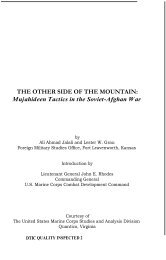hindustani fanatics, india's pashtuns, and deobandism â connections
hindustani fanatics, india's pashtuns, and deobandism â connections
hindustani fanatics, india's pashtuns, and deobandism â connections
- No tags were found...
You also want an ePaper? Increase the reach of your titles
YUMPU automatically turns print PDFs into web optimized ePapers that Google loves.
Hindustani Fanatics, India’s Pashtuns, <strong>and</strong> Deob<strong>and</strong>ism – ConnectionsAllen explains the more pragmatic approach taken by the other group, led by Muhammad Qasim <strong>and</strong> Rashid Ahmad:“Their leaders were Muhammad Qasim <strong>and</strong> Rashid Ahmad, two of the four-man group of jihadis that had left Delhi in the summer of 1857 tocreate their own Dar ul-Islam at Thana Bhawan. Muhamm<strong>and</strong> Qasim had acted as the group’s military comm<strong>and</strong>er <strong>and</strong> may well have had a h<strong>and</strong> inthe massacre at Shamlee mosque; Rashid Ahmad had presided over the imposition of sharia as the group’s judge.“In May 1866, one year after the ending of the Patna trial, these two mullahs set up their own madrassa at Deob<strong>and</strong>, a small town seventy-fivemiles north of Delhi <strong>and</strong> within a day’s march of their earlier stamping-ground at Thana Bhawan.” 98Firm evidence connecting Muhammad Qasim <strong>and</strong> Rashid Ahmad to the Rohilla Pashtuns is not available in the literature surveyed to thispaper, but sufficient circumstantial evidence can be found to support this assertion. For instance, Thana Bhawan, located north of Delhi is insideIndia’s current Uttar Pradesh state, the Rohilla homel<strong>and</strong> destroyed by Shuja ud-Daulah <strong>and</strong> Warren Hasting’s East India Company forces in 1774.Iqbal Husain explains that this region was populated by large numbers of “Afghans” that we now know were Rohillas, or probably Yusufzai Pashtuns.Muhammad Qasim Nanautawi’s surname was derived from his village of origin, Nanauta, which is located in Uttar Pradesh’s Saharanpurdistrict. According to Iqbal Husain, Nanauta was under Afghan control <strong>and</strong> they lost some of the l<strong>and</strong> they had owned by 1844. 99Rashid Ahmad Gangohi’s surname was also derived from his village of origin, Gangoh, another of Uttar Pradesh’s Afghan villages that wasalso located in Shahranpur district. 100Finally, not only was Deob<strong>and</strong> within a “day’s march” of Thana Bhawan, Gangoh <strong>and</strong> Nanauta were even closer. Deob<strong>and</strong> is also locatedin what was once Rohilkh<strong>and</strong>, populated <strong>and</strong> once dominated by Yusufzai Pashtuns. It appears probable that the Deob<strong>and</strong>i Madrassa was probablycreated by a pair of Yusufzai Pashtuns, probably taught in Pashto, as well as Arabic, <strong>and</strong> the missionaries created at Deob<strong>and</strong> were quickly acceptedby the Pashtuns on the Afghan frontier, especially in the northern sections where they called themselves “Pakhtuns” in a Pashto dialect that wasessentially unintelligible in the Pashtun south <strong>and</strong> where Qadiriya Sufism’s influence remained strong. The difference was simple: the early graduatesof Deob<strong>and</strong>’s new madrassa, probably Rohilla Yusufzais in many cases, were unable to communicate with the southern Pashtuns <strong>and</strong> their effortswere concentrated in the Pashtun belt’s northern areas where the missionaries shared a common language with those tribes they sought to influence<strong>and</strong> covert to the new form of Islam.The connection to India’s Pashtuns appears to have occurred well before Sayed Ahmad Shah led his followers to the region adjoiningPeshawar. Shah Waliullah, the mentor of many of India’s future religious revolutionaries, was from the town of Phulat in what is now Muzaffarnagardistrict of Uttar Predesh – the center of the Rohilla Pashtuns. One of his ancestors migrated to India <strong>and</strong> settled in the town of Rohtak 101 , a locationconnected to the Pashtuns by the word “Roh” in its name – Rohilla. While Rohtak 102 is located in a strategic location west of Delhi, it is very possible98. Ibid, pg. 206.99. Husain, pg. 7.100. From Wikipedia: Gangoh is a city <strong>and</strong> a municipal board in Saharanpur district in the state of Uttar Pradesh, India.101. From Wikipedia: The forefather of Shah Waliullah, Shaikh Shamsuddin Mufti came to the subcontinent <strong>and</strong> settled in Rothak during the initial period of Islamic rule.102. Lying close to the imperial city of Delhi, the tract which now comprises the Rohtak district,was often granted in military Jagir by the Sultan <strong>and</strong> Mughal emperors tothe Nobles of the court. For this reason Rajput, Brahman, Afghan, <strong>and</strong> Baluch chiefs have at different times enjoyed its revenues. http://rohtak.nic.in/ginf1.htm (accessed 25September 2008)Tribal Analysis Center, 6610-M Mooretown Road, Box 159. Williamsburg, VA, 23188
















